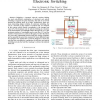Free Online Productivity Tools
i2Speak
i2Symbol
i2OCR
iTex2Img
iWeb2Print
iWeb2Shot
i2Type
iPdf2Split
iPdf2Merge
i2Bopomofo
i2Arabic
i2Style
i2Image
i2PDF
iLatex2Rtf
Sci2ools
INFOCOM
2006
IEEE
2006
IEEE
Power-Law Tradeoffs Between Optical and Electronic Switching
— Designing a transport network requires finding the most cost-effective combination of electronic and optical switching to support the given demands. This task is not trivial because the solution space is so large. Furthermore, there are many interacting design variables. In electronic switching, the cost is a function of the number of packets that are switched in the routers, which directly corresponds to the average hop count ( ¯H). The dominant cost of optical switching is a function of the total number of wavelengths used in the network (S) or the maximum number of wavelengths used on any fiber (W ) and the number of transceivers (L) used. In this paper, we show that there is a power-law relationship between each pair of these variables, and we quantify the power-law exponent for many different types of topologies. Our results allow a network designer to choose not only the most cost-effective combination of electronic and optical switching, but also the best fiber topology ...
Communications | Cost-effective Combination | INFOCOM 2006 | Interacting Design Variables | Optical Switching |
| Added | 11 Jun 2010 |
| Updated | 11 Jun 2010 |
| Type | Conference |
| Year | 2006 |
| Where | INFOCOM |
| Authors | Huan Liu, Benjamin K. Chen, Fouad A. Tobagi |
Comments (0)

